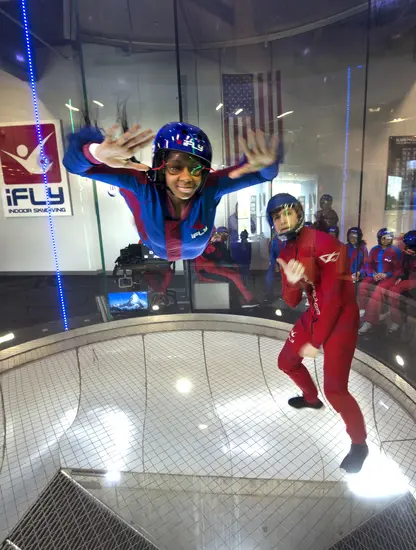
Education
Educational Activities
The Museum’s extensive education and public engagement activities span a spectrum as broad as our collection. From in-museum hands-on experiences to camps and in-residence teacher enrichment programs to lectures covering topics across the universe, they all seek to share the wonders of aviation, space flight, and research to inspire the next generations of explorers, innovators and researchers.
In FY 2018, the Museum continued to look for innovative ways to engage audiences of all ages and demographics with an increased focus on underserved communities, and a deepening of concentration on STEAM (science, technology, engineering, art, and mathematics) topics. A new STEAM camp for girls and multi-year teacher training institute are helping spread STEAM learning well beyond the Museum’s walls (see Spotlight below).
Programs reached hundreds of thousands of visitors in our National Mall building and Udvar-Hazy Center and many more online. This including activities such as astronomical observing, story time reading for younger visitors, art projects, docent-led tours, science demonstrations, planetarium shows, interactive video conferences, and teacher professional development.
Some highlights of FY 2018 include:
- Lectures by experts in planetary research, aviation pioneers, aviation journalists and more that were attended by thousands in person and streamed worldwide on the internet. Topics covered included the latest use of drones and a look at our future with them and panel of pilots who broke through social restraints and prejudices to be aviators.
- Programs targeting young adults including the world’s largest Yuri’s Night celebration, the Hemispheres program in collaboration with the Hirshhorn Museum, and an art installation of a room from the movie 2001: A Space Odyssey that drew great attendance.
- Daily astronomy education programs that drew almost 50,000 participants at both facilities and another 62,000 people who participated in Discovery Station events. The astronomy team also provided programs for Yuri’s Night and Solstice Saturday.
- Eight Family Days including the always popular Air & Scare Halloween event (made possible by Mars Wrigley Confectionery US LLC) at the Udvar-Hazy Center; the Heritage Family Day Series sponsored by Northrop Grumman marking diverse ethnic and cultural communities that have contributed to aviation and space exploration. These programs are rich with hands-on activities and offer captivating short talks. The Museum added a WWI Family Day and musical presentation to commemorate the 100th anniversary. Innovations in Flight Day (sponsored by United Airlines) continued to provide guests the unique opportunity to engage with pilots and explore aircraft flown in for the day.
Spotlight
Ideas That Defy – She can’t? Oh, YES! S.H.E. Can
Two exciting new education programs launched in FY 2018 promise to both set a new generation on a path of innovation and discovery, and give those who will guide them the tools to spread the Museum’s mission far and wide.
In its first year, the “S.H.E. Can” STEM Summer Camp gave 57 middle school girls the chance to experience hands-on flight instruction on FAA-certified simulators, a 30-minute discovery flight with a local flight school, a high-altitude weather balloon launch and indoor skydiving. They met women working in a variety of aviation fields, such as air traffic control, cyber security, and commercial aviation. The program focuses on students from underserved communities to broaden the diversity of the next generation of inventors and explorers.

Participants in the first Teacher Innovator Institute worked with Museum educators to develop their skills in sharing STEM education in new and engaging ways.
The summer also brought the first class of the Teacher Innovator Institute (TII). Thirty teachers spent two weeks in Washington, DC, working with education and STEM experts to explore the connections between informal STEM education and authentic learning. Each teacher developed an individual project that they could take back to their school and gain the skills to incorporate museum learning into their practice, and meet colleagues from around the country. There is no cost for teachers to participate.
Teachers remain with the program for three summers, returning to Washington, DC, each year to reconnect, develop their practice, and mentor the newest classes of Innovators.
“Our two newest initiatives SHE Can and TII focus on the impressionable middle school years, where students are exploring career options and teachers have the ability to shape student confidence and skills in STEM,” said Barb Gruber, assistant director Education, school programs. “The museum has the ability to provide unique experiences that tell the history of innovation and grow the capacity of the next generation by expanding opportunities for students and professional knowledge for educators.”





